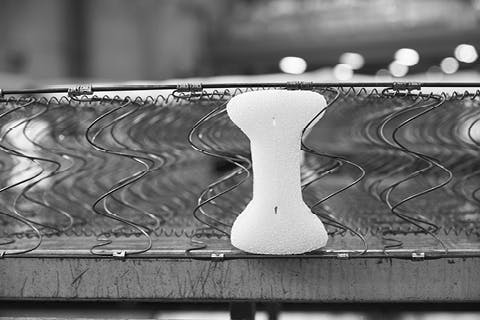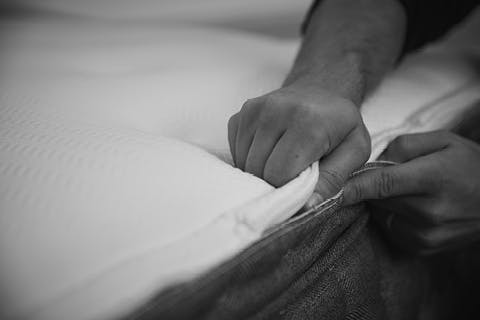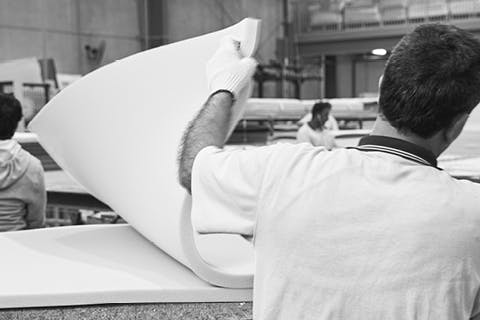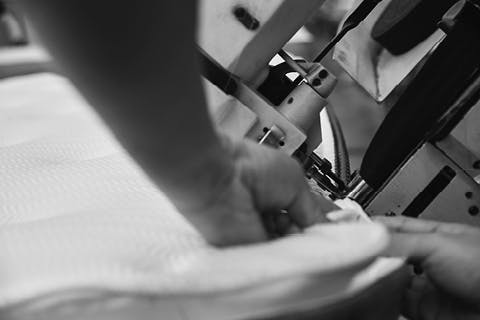What’s inside a mattress?

Have you ever wondered what’s inside a mattress? Like a good book, it’s difficult to judge a mattress by its cover. But, just for a moment, let’s imagine you have a special lens that allows you to see through to the inside. You’d see differences between certain types like coil spring, pocket spring and foam. We take a look inside these mattress types to help you take the guesswork out of buying your new mattress so you can get a better night’s sleep.
What’s a mattress made up of?
A conventional mattress consists of two primary sections - a core or ‘support system’ and the ‘comfort layer’, wrapped up in a thick fabric referred to as the ticking. Further comfort layers cover the mattress and help provide cushioning and improved support.
What’s a support system?
When you’re on the hunt for a new mattress, it’s important to consider the three types of support systems available to you: coil spring, pocket spring and foam. This is where a lot of the hard work in supporting your body as your sleep takes place. Understanding the basics of each of these support systems will serve as an important start when you begin the search for your new mattress.
Different support systems
1. Coil Spring

As the name suggests, these mattresses feature a coil-based support system in the form of a single length of wire in each row or lattice. Each wire is shaped into a coil, similar to an ‘S’ shape and then interlaced to the top and bottom of the spring frame in a uniformed style. The surface can feel bouncier and can have limited motion isolation, so you may be able to feel your partner tossing and turning at night. Because the coil is connected, each spring can draw support from the adjacent springs, and this can help improve support and resistance. But of course, the quality of the coil mattress depends on the gauge, spring height, and quality of the wire. We explore the two types of coil spring mattresses in more detail.
1a. Bonnell Spring
These are the oldest type of mattress springs. These springs were often used in buggy seats in the 19th century. Shaped a little like an hourglass, these wire springs are knotted or wrapped to the top and bottom of the wire frame. Each spring is joined to adjacent springs by small wire spirals called hellicals, and the entire structure is then reinforced with a border wire to ensure the mattress retains its shape. The level of support in these types of mattresses depends on the number of springs and thickness of the wire. The lower the thickness of the wire, or gauge as it’s often called, the firmer the mattress, and usually, the more springs in a mattress, the more support.
1b. Offset Coil
These coils are similar to Bonnell springs, except they have a squared head, and the angles of the wire vary. This is how the wire gets its name. The logic behind the squared shape is that the coils can contour to your body better. The tops of the coils, which are joined by hellicals, create a hinging effect for softer pressure, while the main part of the coil reacts to stronger pressure. This means an offset coil mattress generally offers softness on top and firmness under that but, again this is dependent on the quality of the wire and the number of coils in the mattress.
2. Pocket Spring

A pocket spring mattress is made with individual springs sealed in separate pockets below the comfort layer and/or foam. As the springs aren’t wired together like an ordinary coil spring, they generally operate independently from each other to help improve support and pressure relief. This ensures each spring can adjust to your body in any sleeping position, and if one person moves around on one side of the mattress, they are less likely to disturb the springs on the opposite side of the bed. As a general rule, the more coils, the more responsible and motion-controlled the mattress is.
Thanks to advanced technology, mattresses can now be created with different zones. This means that different sections of the mattress have different levels of support. So while there are more springs or thicker wire in some areas of the mattress, there are fewer springs and thinner wire in other areas. There are typically three different pocket spring types:
2a. 3-Zone: Features a zone across the centre third of the mattress to assist in providing additional support.
2b. 5-Zone: Features 5 zones to help provide additional conforming support to your hips and shoulders.
2c. 7-Zone: Features 7 zones to help provide additional conforming support to your hips and shoulders.
3. Spring Free

If you were to look inside a memory foam mattress, you would usually see three things: the support core, the top layer and the cover. The top layer of memory foam is made from a substance called viscoelastic and is highly absorbent and soft. When you lay on a memory foam mattress, you usually feel like you're sinking into a cloud and that your weight is being absorbed. If you were to jump up quickly and had a special lens, you would see an imprint of your body on the memory foam as there are no coils. After a minute or two, the foam returns to its original state, ready to support your next movement and help improve support and pressure relief as you sleep at night.
Comfort Layer Materials:
We went into detail on the support system for the bottom layer of your mattress above, but what does the comfort layer do? The comfort layer can be described as the top part of the mattress, made with soft pillowy materials to help reduce the pressure of the mattress on your body as you slumber.
Different comfort materials
4. Foam

Foam is known for its ability to conform comfortably to the body and soften with pressure. When considering a foam comfort layer, there are two types to choose from.
4a. Gel Foam
Gel foam or gel-infused foam is a form of foam that has been pumped full of gel. It’s the kind of material that can help disperse heat and offer improved pressure relief. As a side fact, the gel microbeads used in a gel-infused foam mattress can serve to increase the density of your mattress.
4b. Memory Foam
A memory foam comfort layer is made out of a polymer known as polyurethane. This is a material often found in most sofas, mattresses, car seats and spray foam. Like gel foam, it can soften when pressure is applied due to this material and can help provide improved pressure relief. Mattresses with memory foam ordinarily have a longer lifespan than spring mattresses.
5. Pillowtop

Mattresses with a pillowtop are often found in hotels and considered by many as the pinnacle of luxury. If you’ve ever tried a pillow top mattress, it feels like sleeping on a cloud. This is due to additional layers of medium-density latex, cotton or foam (depending on the individual mattress) in comparison to an ordinary mattress. This top layer of padding is great for improved comfort and support as you sleep each night, as it can help evenly distribute your weight.
6. Non-Pillowtop
In contrast to the softer pillow top, the non-pillowtop surface offers a firmer feel as it doesn’t feature the additional layer of softness. There are several reasons why people may prefer a firm mattress to the former listed above. In most cases, a non-pillowtop mattress is cooler as you tend to sleep on top of the mattress and not into it. Some also believe that this type of mattress or a ‘flat top mattress’ is much easier to move on and get in and out of. Non-pillowtop tends to suit heavier builds in terms of support and alignment.
Let’s face it. Buying a new mattress can be hard work, but understanding the differences between certain mattress types like the coil spring, pocket spring, and foam will ensure you’re more confident when deciding what’s right for you. If you’d like more information or assistance in choosing a new bed, read our Mattress Buying Guide, try our Mattress Quiz or visit your local Snooze store and try the Snooze Profiler®.